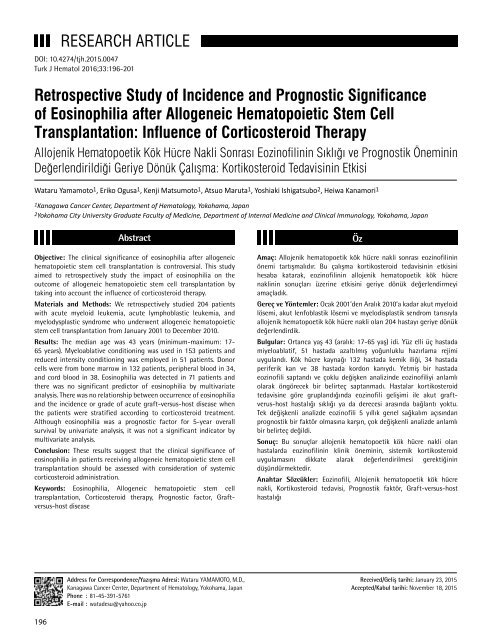Turkish Journal of Hematology Volume: 33 - Issue: 3
You also want an ePaper? Increase the reach of your titles
YUMPU automatically turns print PDFs into web optimized ePapers that Google loves.
RESEARCH ARTICLE<br />
DOI: 10.4274/tjh.2015.0047<br />
Turk J Hematol 2016;<strong>33</strong>:196-201<br />
Retrospective Study <strong>of</strong> Incidence and Prognostic Significance<br />
<strong>of</strong> Eosinophilia after Allogeneic Hematopoietic Stem Cell<br />
Transplantation: Influence <strong>of</strong> Corticosteroid Therapy<br />
Allojenik Hematopoetik Kök Hücre Nakli Sonrası Eozin<strong>of</strong>ilinin Sıklığı ve Prognostik Öneminin<br />
Değerlendirildiği Geriye Dönük Çalışma: Kortikosteroid Tedavisinin Etkisi<br />
Wataru Yamamoto 1 , Eriko Ogusa 1 , Kenji Matsumoto 1 , Atsuo Maruta 1 , Yoshiaki Ishigatsubo 2 , Heiwa Kanamori 1<br />
1Kanagawa Cancer Center, Department <strong>of</strong> <strong>Hematology</strong>, Yokohama, Japan<br />
2Yokohama City University Graduate Faculty <strong>of</strong> Medicine, Department <strong>of</strong> Internal Medicine and Clinical Immunology, Yokohama, Japan<br />
Abstract<br />
Objective: The clinical significance <strong>of</strong> eosinophilia after allogeneic<br />
hematopoietic stem cell transplantation is controversial. This study<br />
aimed to retrospectively study the impact <strong>of</strong> eosinophilia on the<br />
outcome <strong>of</strong> allogeneic hematopoietic stem cell transplantation by<br />
taking into account the influence <strong>of</strong> corticosteroid therapy.<br />
Materials and Methods: We retrospectively studied 204 patients<br />
with acute myeloid leukemia, acute lymphoblastic leukemia, and<br />
myelodysplastic syndrome who underwent allogeneic hematopoietic<br />
stem cell transplantation from January 2001 to December 2010.<br />
Results: The median age was 43 years (minimum-maximum: 17-<br />
65 years). Myeloablative conditioning was used in 153 patients and<br />
reduced intensity conditioning was employed in 51 patients. Donor<br />
cells were from bone marrow in 132 patients, peripheral blood in 34,<br />
and cord blood in 38. Eosinophilia was detected in 71 patients and<br />
there was no significant predictor <strong>of</strong> eosinophilia by multivariate<br />
analysis. There was no relationship between occurrence <strong>of</strong> eosinophilia<br />
and the incidence or grade <strong>of</strong> acute graft-versus-host disease when<br />
the patients were stratified according to corticosteroid treatment.<br />
Although eosinophilia was a prognostic factor for 5-year overall<br />
survival by univariate analysis, it was not a significant indicator by<br />
multivariate analysis.<br />
Conclusion: These results suggest that the clinical significance <strong>of</strong><br />
eosinophilia in patients receiving allogeneic hematopoietic stem cell<br />
transplantation should be assessed with consideration <strong>of</strong> systemic<br />
corticosteroid administration.<br />
Keywords: Eosinophilia, Allogeneic hematopoietic stem cell<br />
transplantation, Corticosteroid therapy, Prognostic factor, Graftversus-host<br />
disease<br />
Öz<br />
Amaç: Allojenik hematopoetik kök hücre nakli sonrası eozin<strong>of</strong>ilinin<br />
önemi tartışmalıdır. Bu çalışma kortikosteroid tedavisinin etkisini<br />
hesaba katarak, eozin<strong>of</strong>ilinin allojenik hematopoetik kök hücre<br />
naklinin sonuçları üzerine etkisini geriye dönük değerlendirmeyi<br />
amaçladık.<br />
Gereç ve Yöntemler: Ocak 2001’den Aralık 2010’a kadar akut myeloid<br />
lösemi, akut lenfoblastik lösemi ve myelodisplastik sendrom tanısıyla<br />
allojenik hematopoetik kök hücre nakli olan 204 hastayı geriye dönük<br />
değerlendirdik.<br />
Bulgular: Ortanca yaş 43 (aralık: 17-65 yaş) idi. Yüz elli üç hastada<br />
miyeloablatif, 51 hastada azaltılmış yoğunluklu hazırlama rejimi<br />
uygulandı. Kök hücre kaynağı 132 hastada kemik iliği, 34 hastada<br />
periferik kan ve 38 hastada kordon kanıydı. Yetmiş bir hastada<br />
eozin<strong>of</strong>ili saptandı ve çoklu değişken analizinde eozin<strong>of</strong>iliyi anlamlı<br />
olarak öngörecek bir belirteç saptanmadı. Hastalar kortikosteroid<br />
tedavisine göre gruplandığında eozin<strong>of</strong>ili gelişimi ile akut graftverus-host<br />
hastalığı sıklığı ya da derecesi arasında bağlantı yoktu.<br />
Tek değişkenli analizde eozin<strong>of</strong>ili 5 yıllık genel sağkalım açısından<br />
prognostik bir faktör olmasına karşın, çok değişkenli analizde anlamlı<br />
bir belirteç değildi.<br />
Sonuç: Bu sonuçlar allojenik hematopoetik kök hücre nakli olan<br />
hastalarda eozin<strong>of</strong>ilinin klinik öneminin, sistemik kortikosteroid<br />
uygulamasını dikkate alarak değerlendirilmesi gerektiğinin<br />
düşündürmektedir.<br />
Anahtar Sözcükler: Eozin<strong>of</strong>ili, Allojenik hematopoetik kök hücre<br />
nakli, Kortikosteroid tedavisi, Prognostik faktör, Graft-versus-host<br />
hastalığı<br />
Address for Correspondence/Yazışma Adresi: Wataru YAMAMOTO, M.D.,<br />
Kanagawa Cancer Center, Department <strong>of</strong> <strong>Hematology</strong>, Yokohama, Japan<br />
Phone : 81-45-391-5761<br />
E-mail : watadesu@yahoo.co.jp<br />
Received/Geliş tarihi: January 23, 2015<br />
Accepted/Kabul tarihi: November 18, 2015<br />
196

















